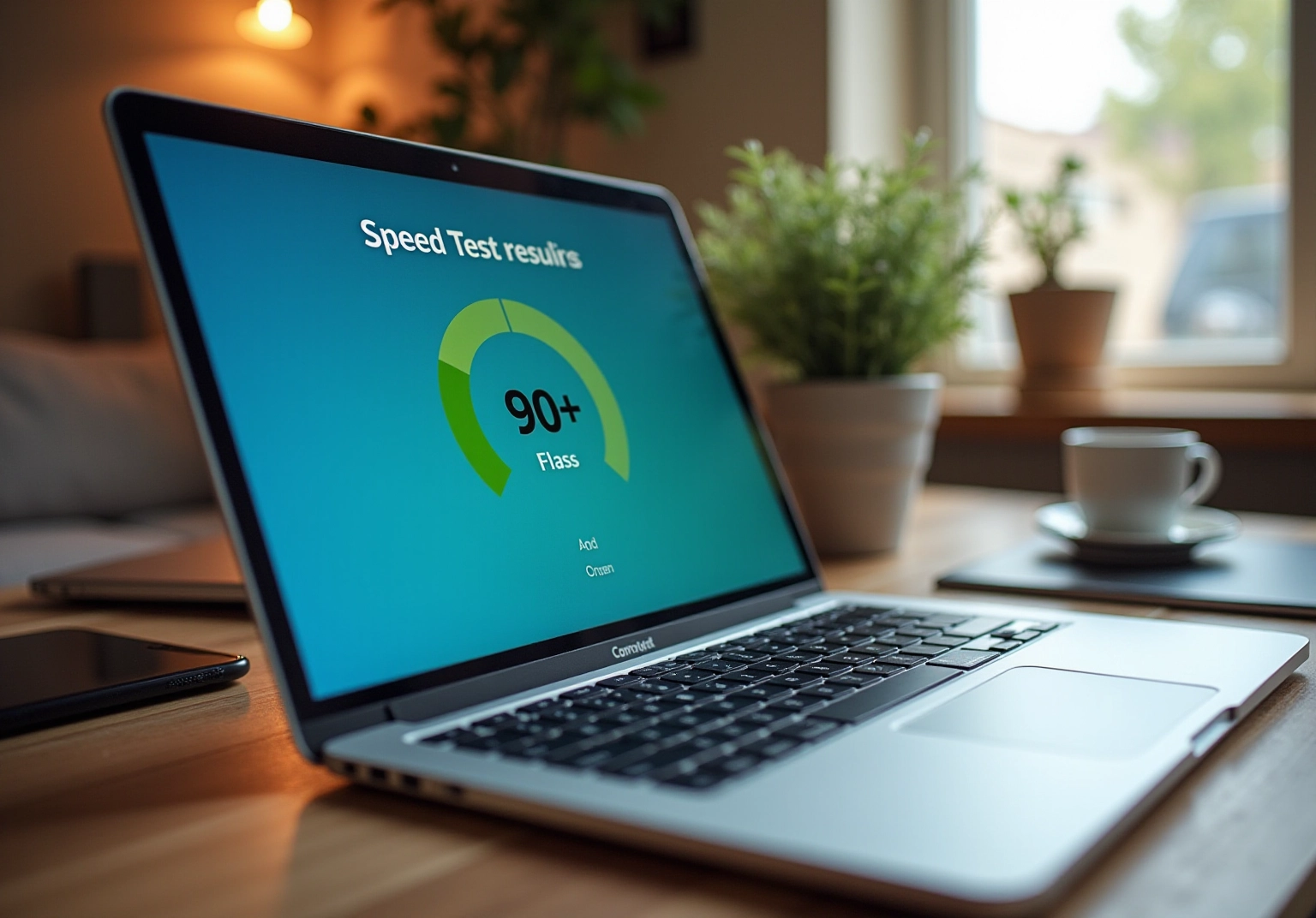
Overview
The article "5 Steps for a Speed Check for Website Optimization" centers on a structured methodology designed to evaluate and enhance website loading speed, ultimately aiming to improve user experience and conversion rates. It underscores the paramount significance of website speed, asserting that even slight delays can precipitate considerable declines in user engagement and sales. This establishes speed optimization not merely as an enhancement but as a strategic necessity for achieving online success.
Introduction
In today's digital landscape, website speed has become a critical factor where every second counts and user patience wanes. Studies indicate that even a minor delay can result in considerable losses in conversions and customer retention. Therefore, understanding how to optimize website speed is not merely optional; it is essential.
What strategies can businesses adopt to ensure their websites not only meet but exceed user expectations for speed? This guide outlines five crucial steps for conducting a speed check and optimizing website performance, unlocking the potential for enhanced user experiences and increased revenue.
Understand the Importance of Website Speed
A speed check for website performance is essential for enhancing visitor experience and significantly influences interactions with your site. Research indicates that even a one-second delay in page retrieval time can lead to a 7% decline in conversions. Furthermore, 53% of individuals will abandon a site if it takes more than 3 seconds to load, underscoring the urgent need for speed enhancement.
Search engines like Google also incorporate page speed into their ranking algorithms, meaning that a sluggish site can detrimentally affect your visibility in search results. In an era where individuals demand immediate access to information, any delay can lead to frustration and increased abandonment rates. For instance, research shows that:
- 46% of clients would never return to an online platform with poor loading times.
- 64% of individuals encountering slow performance are less likely to revisit.
A mere one-second delay could potentially cost $2.5 million in lost sales annually for a site generating $100,000 per day. Therefore, a is not merely a technical requirement; it is a strategic necessity for improving client satisfaction and driving conversions.
As Isabella Edwards, a Technical SEO Content Manager, aptly states, "Speed is the currency of the internet." Brands that have successfully improved their online speed have reaped significant benefits, such as increased traffic and enhanced conversion rates, highlighting the importance of prioritizing this critical aspect of digital performance.
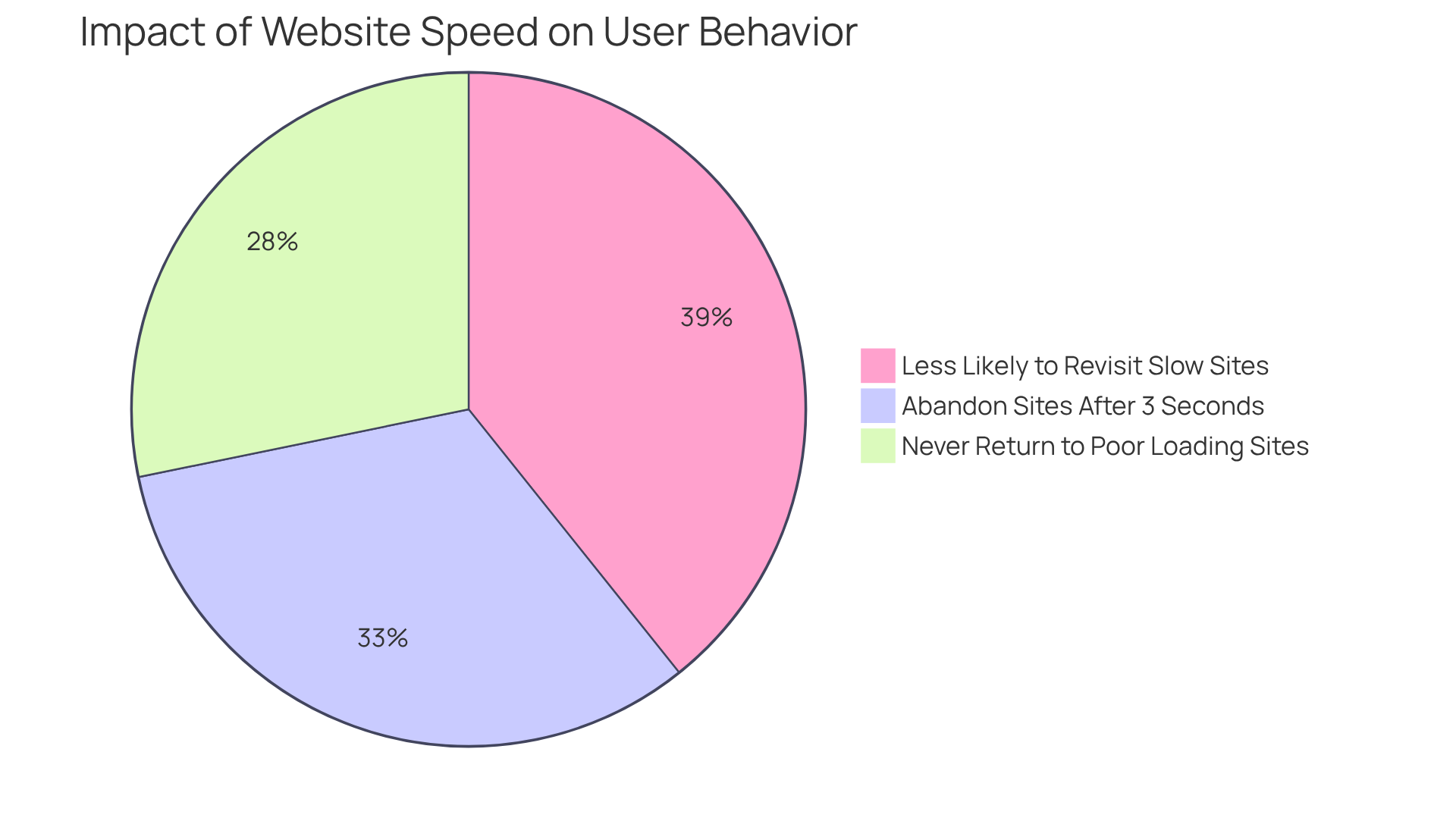
Identify Key Metrics for Speed Measurement
To effectively measure your website's speed, focus on critical performance metrics that significantly influence user experience and conversion rates:
- Page Load Time: This metric reflects the total time required for a page to fully load in a browser. E-commerce sites should aim for a loading period of under three seconds, as each second of delay can lead to a 32% increase in bounce likelihood when loading times extend from 1 second to 3 seconds.
- Time to First Byte (TTFB): This measures the duration it takes for the server to respond to a request. A lower TTFB indicates a more responsive server, which is vital for maintaining audience engagement.
- Largest Contentful Paint (LCP): This metric evaluates loading performance by measuring the time it takes for the largest visible content element to load. For an optimal experience, LCP should be under 2.5 seconds. In 2023, 74% of websites achieved a good LCP score on desktop, while 61.4% did so on mobile, underscoring the necessity of optimizing this metric.
- Cumulative Layout Shift (CLS): CLS assesses visual stability by quantifying how much content shifts during loading. A low CLS score ensures users can interact with the content without unexpected movements, thereby enhancing usability.
- First Input Delay (FID): This measures the time it takes for the browser to respond to the first interaction, such as clicking a button. A quick FID is crucial for a seamless user experience.
To analyze these metrics effectively, tools like Google PageSpeed Insights and WebPageTest offer a speed check for website performance. By consistently monitoring these metrics, you can uncover critical insights into your site's performance and identify specific areas needing optimization. This proactive approach not only enhances user satisfaction but also leads to higher conversion rates and overall business success. As Peter Drucker wisely stated, "What gets measured gets managed.
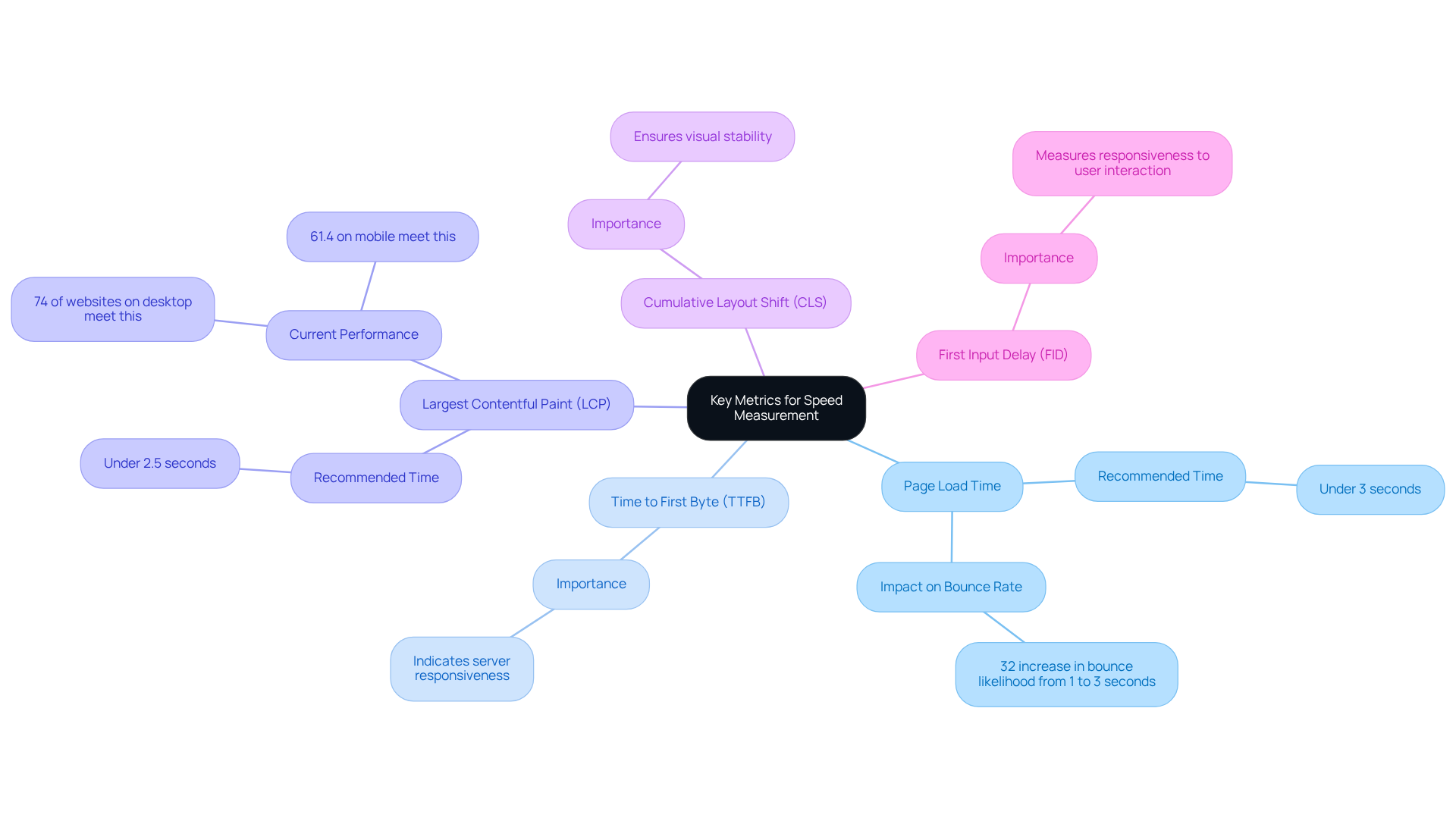
Conduct a Speed Test Using Recommended Tools
To effectively conduct a speed test, it is essential to utilize the following recommended tools:
- Google PageSpeed Insights: This tool provides a thorough analysis of your website's performance, grading it on a scale of 1 to 100. Scores above 85 indicate good performance, and it offers actionable suggestions for improvement, including image optimization and CSS delivery enhancements.
- GTmetrix: GTmetrix provides comprehensive reports on page loading durations, page size, and the number of requests. It allows users to test from multiple locations and compare performance across different connection types, making it a valuable resource for understanding global user experiences.
- Pingdom: This tool enables speed testing from various locations worldwide, offering insights into how your site performs across different regions. It generates comprehensive reports that include performance grades and historical data, helping you track improvements over time.
- : For advanced testing options, allows you to simulate different devices and connection speeds. This can provide a more nuanced understanding of how your site performs under various conditions.
To conduct a test, simply input your site URL into one of these tools and examine the outcomes. Focus on the key metrics highlighted in the previous section to gain insights into your site's performance. Regular speed tests are essential, as even a slight delay can result in significant declines in engagement and conversion rates. Research indicates that 45% of users are less inclined to buy from a platform with slower-than-anticipated page speed, and slow-loading online platforms can result in an annual decline of $2.6 billion in sales for companies. Furthermore, ensure that the selected speed test tool is compatible with your platform and other systems to maximize effectiveness.

Interpret Speed Test Results for Actionable Insights
Upon receiving your speed test results, it is imperative to concentrate on the following critical aspects:
- Overall Score: Most tools will yield a score reflecting your website's performance. A score exceeding 90 in the speed check for website signifies commendable performance, whereas a score below 50 highlights significant issues that require immediate attention.
- Speed check for website: Analyze the loading duration of various components, such as images, scripts, and stylesheets. Identify the elements that are contributing to delays and hindering performance during the speed check for website.
- Recommendations: Typically, these tools will offer following a speed check for website performance. It is crucial to prioritize these recommendations based on their potential impact on response time and user experience.
For example, if your test indicates that images are consuming excessive time to load, consider optimizing their size or format. If scripts are obstructing rendering, explore options for deferring or asynchronously loading them to enhance overall performance.
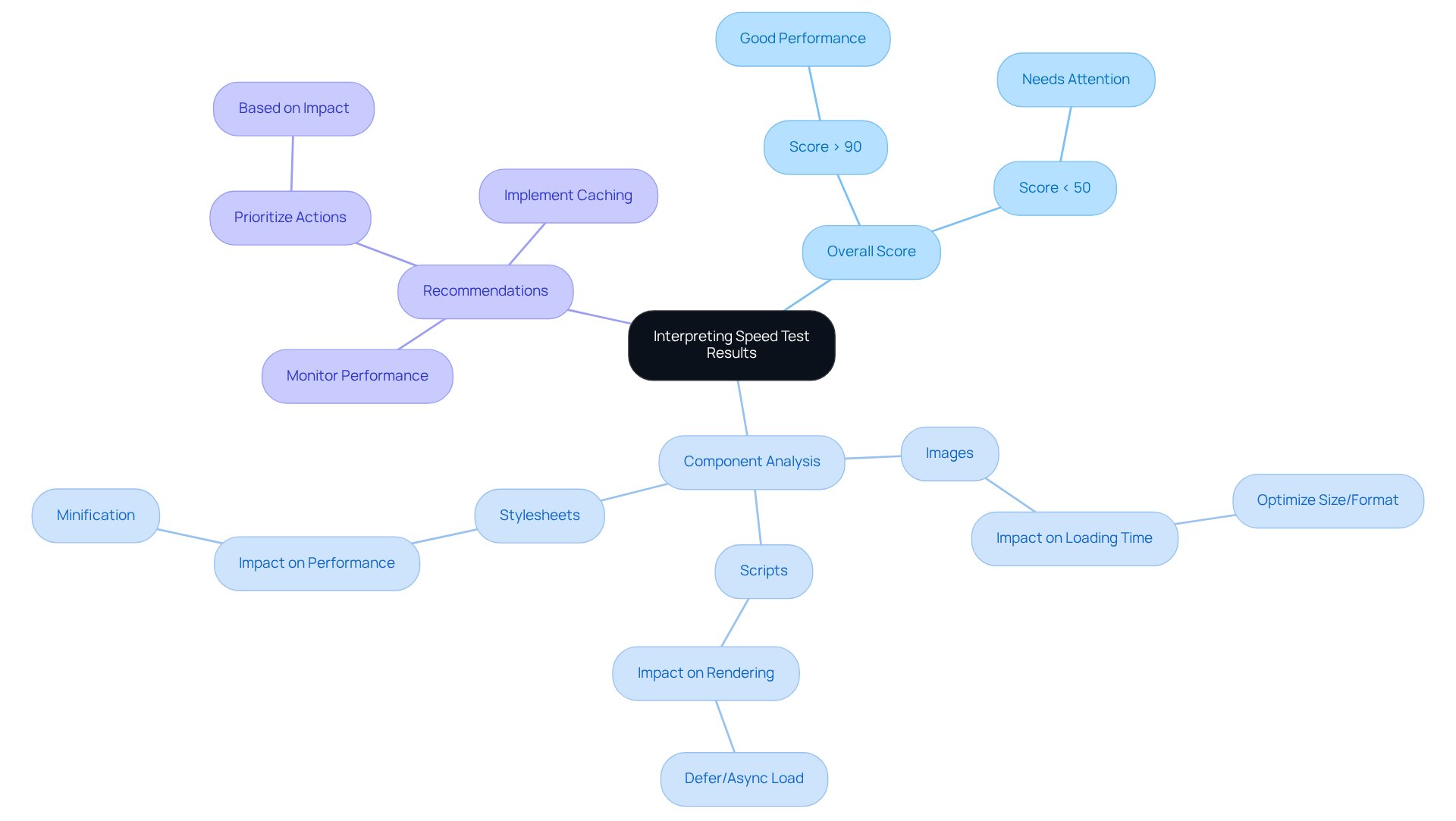
Implement Optimization Strategies to Enhance Speed
To enhance your website's speed, consider implementing the following strategies:
- Optimize Images: Compress images without sacrificing quality using tools like TinyPNG, ImageOptim, or the WebP Express plugin. Studies indicate that enhancing images can greatly decrease loading duration; a one-second lag in mobile loading periods may affect conversion rates by as much as 20%. Furthermore, a mere one-second delay in site loading speed could decrease conversions by 7%.
- Minimize HTTP Requests: Decrease the quantity of elements on your page to shorten loading durations. Merging CSS and JavaScript files can lead to quicker loading speeds, as fewer requests are sent to the server.
- Enable Browser Caching: Configure caching to retain commonly accessed resources, which can decrease retrieval durations for returning visitors. This technique is essential for enhancing user experience and retention.
- Utilize a Content Delivery Network (CDN): Distribute your content across various servers to for users in different geographical areas. A CDN can significantly improve performance, especially for brands with a global audience.
- Minify CSS, JavaScript, and HTML: Remove unnecessary characters from your code to reduce file sizes and enhance speed. This practice results in a more efficient site, as smaller files transfer more quickly.
- Implement Lazy Loading: Retrieve images and videos only when they appear in the viewport, which decreases initial loading duration and enhances overall satisfaction. This technique is particularly effective for pages with numerous media elements.
By adopting these strategies, you can conduct a speed check for your website, significantly enhancing its speed and leading to improved experiences for visitors and increased conversion rates. Rapid loading durations are essential; 53% of users abandon mobile sites that require more than three seconds to load. For instance, a performance audit revealed that a WooCommerce site improved its loading time from 6.5 seconds to 2.1 seconds after implementing these optimization strategies, demonstrating the effectiveness of these techniques.
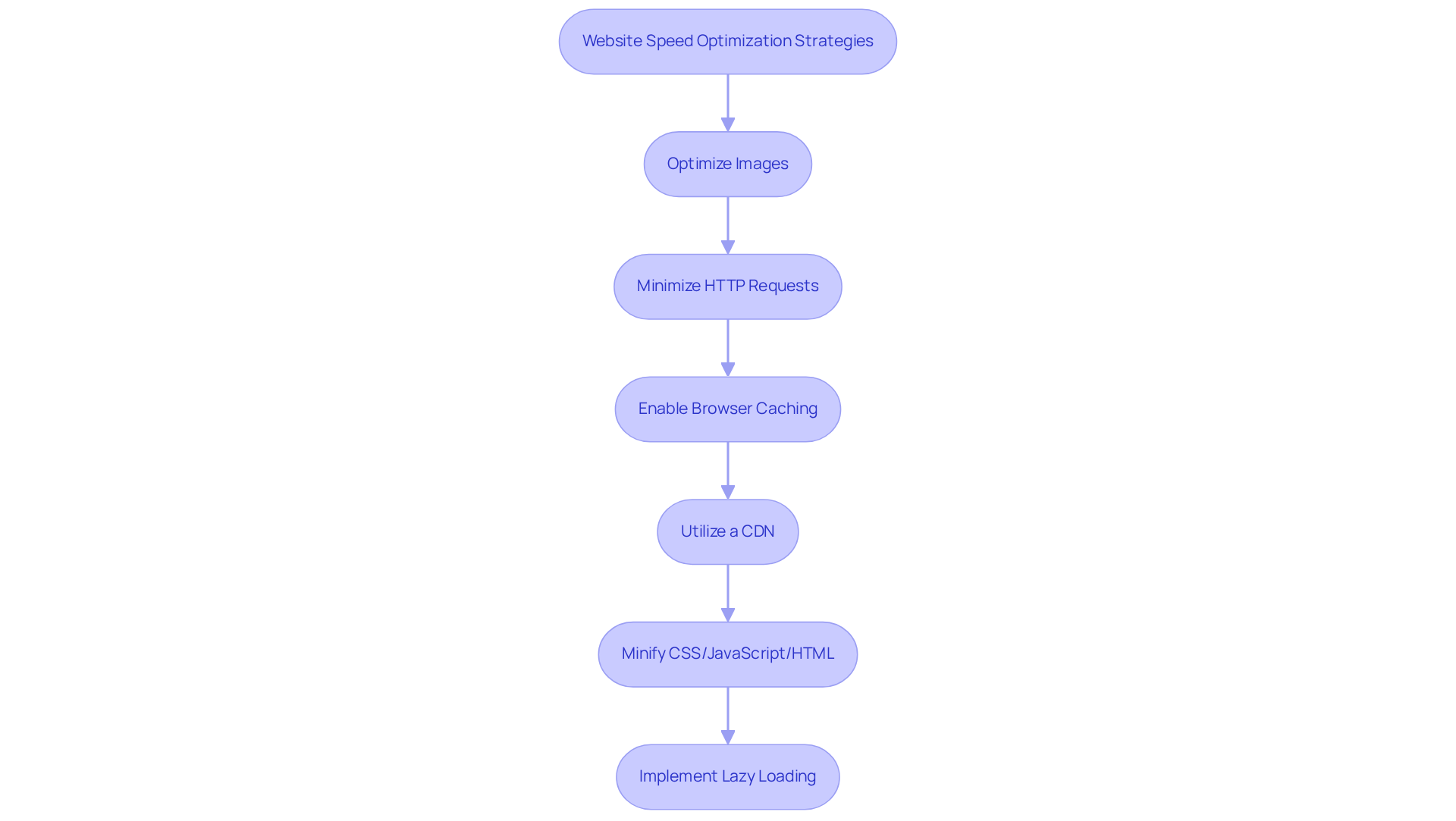
Conclusion
A swift website transcends technical necessity; it stands as a cornerstone of user satisfaction and business success. The imperative of website speed optimization is emphasized by the substantial effects that loading times exert on user engagement and conversion rates. Research indicates that even minor delays can precipitate significant declines in user retention and sales, underscoring the necessity for businesses to prioritize speed assessments and enhancements.
Key insights from the article elucidate the importance of grasping critical performance metrics such as:
- Page Load Time
- Time to First Byte
- Largest Contentful Paint
By utilizing effective tools like Google PageSpeed Insights and GTmetrix, website owners can conduct comprehensive speed tests and analyze results to pinpoint areas ripe for improvement. Implementing strategies such as:
- Image optimization
- Minimizing HTTP requests
- Leveraging a Content Delivery Network
can yield remarkable improvements in loading times, ultimately fostering a superior user experience.
In a digital arena where user expectations continually escalate, the importance of fast-loading websites is paramount. Businesses that commit to speed optimization not only enhance their search engine rankings but also bolster overall customer satisfaction and loyalty. Taking decisive action to implement these strategies today will pave the way for increased traffic, elevated conversion rates, and enduring success in an increasingly competitive market.
Frequently Asked Questions
Why is website speed important?
Website speed is crucial for enhancing visitor experience, influencing interactions with the site, and can significantly impact conversion rates. Research indicates that even a one-second delay in page retrieval can lead to a 7% decline in conversions, and 53% of individuals will abandon a site if it takes more than 3 seconds to load.
How does website speed affect search engine rankings?
Search engines like Google include page speed in their ranking algorithms. A slow website can negatively affect its visibility in search results, making it harder for users to find the site.
What are the consequences of slow website performance?
Slow website performance can lead to high abandonment rates; for instance, 46% of clients would never return to a platform with poor loading times, and 64% are less likely to revisit a site that performs slowly. Additionally, a one-second delay could potentially cost significant revenue, such as $2.5 million annually for a site generating $100,000 per day.
What are the key metrics to measure website speed?
Key metrics for measuring website speed include:
- Page Load Time: The total time for a page to fully load; e-commerce sites should aim for under three seconds.
- Time to First Byte (TTFB): The duration for the server to respond to a request; a lower TTFB indicates a more responsive server.
- Largest Contentful Paint (LCP): Measures the loading time for the largest visible content element; LCP should be under 2.5 seconds for optimal experience.
- Cumulative Layout Shift (CLS): Assesses visual stability by quantifying content shifts during loading; a low CLS score enhances usability.
- First Input Delay (FID): Measures the time for the browser to respond to the first user interaction; a quick FID is essential for a seamless experience.
How can I analyze website speed metrics?
Tools like Google PageSpeed Insights and WebPageTest can be used to analyze website speed metrics. Consistently monitoring these metrics helps uncover insights into site performance and identify areas for optimization, leading to improved user satisfaction and higher conversion rates.
FAQs











